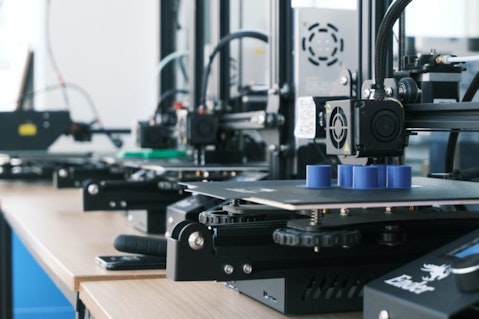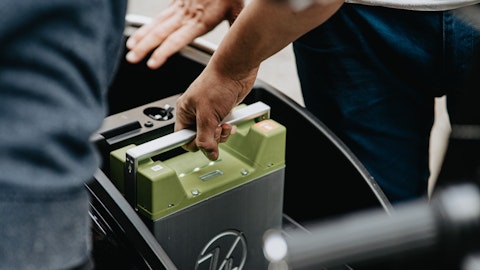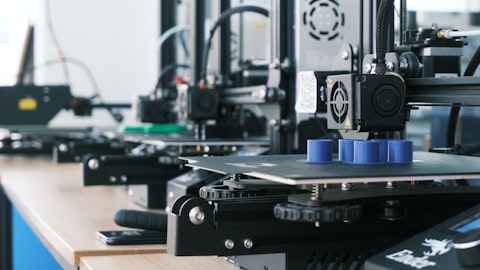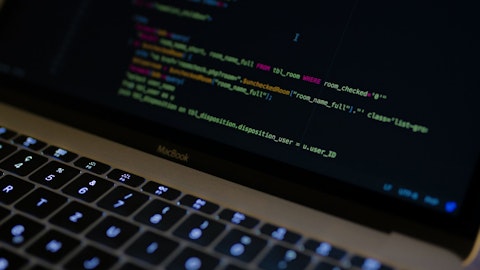Nano Dimension Ltd. (NASDAQ:NNDM) Q4 2022 Earnings Call Transcript March 30, 2023
Operator: Good day, ladies and gentlemen. Welcome to today’s conference to discuss Nano Dimension’s Fourth Quarter and Full Year 2022 Conference Call. My name is Nick and I am your operator for today’s event. On the call with us today are Yoav Stern, Chairman and CEO; Yael Sandler, CFO; and Julien Lederman, Head of Corporate Development. Before we begin, I remind listeners that certain information provided on this call may contain forward-looking statements and the Safe Harbor statement outlined in today’s earnings press release also pertains to this call. If you did not receive a copy of the press release, please view it on the Investor Relations section of the company’s website. Yoav will begin the call with a business update, followed by a question-and-answer session, at which time Yael will answer questions. I’d now like to turn the call over to Nano Dimension’s CEO, Chairman, Yoav Stern. Yoav, please go ahead.
Yoav Stern: Thank you very much, Nick. Hi, everybody. Hopefully, some of you have seen me lately. Wish I could see you today, but I am trying to visualize you. I will go to the business description. You have a presentation in front of you. So I will try not to read the presentation just to scan through it. And if you have questions regarding the business, please write them down and we will be happy to answer later. So we had an excellent year, excellent fourth quarter, the best fourth quarter we ever actually the best quarter we ever had $12.1 million and the best year. It’s not so great it’s not so difficult to have the best year at 44 give or take $44 million, because the years before were hundreds of percent less.
Now, it’s really the challenge going forward and continued to grow in very high rates, which we intend to. So still, it’s good to tell and to let them now let the employees and shareholders know that it was a good year and we had notable advancements with customers and relationship. We sold to very, very serious players, all our products, including Additive Manufactured Electronics, Additive Manufacturing, Additive Electronics, people and organization and NASA Western Defense Forces, all kind of institutions, research institutions, etcetera. We have a partnership with HENSOLDT, which is German-owned or German partly owned public defense company, personal relationship between the CEOs and the management team and partnership J.A.M.E.S is growing and doing very well, 50-50 partnership.
And we got into engagement with the government of Bavaria, which is considering putting a grant in our operation in Germany. So it’s very exciting. On the technology and the business side within the acquisition of two acquisitions this year, one in the beginning, one in midyear and we launched our product in ceramics and metal printers, which are manufactured in Europe, in Netherlands, and we are now in the process of merging actually, those technologies very, very exciting. We are merging the technologies that we acquired with the technologies of Fabrica, which we have and we are going to have new products and technologies, which are merged, not so simple, not so obvious, but justifies the acquisitions because it creates growth engines.
We have patents in the AI and cloud manufacturing, etcetera. Everything else is on the list. And actually, one of the most important that people may overlook is the last point. Progress in standardization of protocols with IPC, IPC is the organization in those protocols for electronic engineering. And we work with them, it’s kind of together with other companies, but we are leading. And the fact that they will set special criteria for Additive Manufacturing Electronics means that our materials and our products will fit the IPC criteria, because it’s going to be not the same criteria like for regular economics, because it’s very, very new technologies. That by itself will enable companies to buy and integrate the product that our machines are making into their own products, because they are going to be IPC approved, extremely, extremely important.
And people understand what does it mean? If you compare it to the business of medical, it’s like FDA approval. A little bit of the numbers. You have now that number is highlighted in front of you. Let me focus on the yearly numbers, because again, the fourth quarter was very, very good, but let’s look at the full year and focus on the fact that we this shows the quarter, we have improvements of gross margins and we have the negative EBITDA, which is mostly affected by the R&D expenses. So if you move for the next one, which shows actually, where is the full year? Full year on the right side sorry, in the bottom part of the slide, you will see that the gross margins are up from last year, which is a manifestation of the fact that mostly our product that our higher margin are being sold more.
So it’s product mix. And we didn’t even start improving the gross margins of the products by reducing the cost of manufacturing. That’s going to be the next step, because we are still in the stage of products penetrating into the market. So most important for us is to put products with customers’ hands even if we reduce the price a little bit or even if we didn’t finish maximizing the value engineering at the cost of goods sold. But that’s the next step. So I expect in the longer term, gross margins to grow because new products with our advanced technology, when it goes out to the market has to have 65% gross margin. And the 46% you see here is the combination of we have 65%, we will have more and we have products that are more mature and are lower than 65% and the average ends up being 46%.
Another thing to pay attention again on the full year in the bottom is the fact that the negative EBITDA of $88 million, out of that $55 million is an investment in R&D. And as I said to people who were listening to me 2 years ago, 1.5 years ago, a year ago, half a year ago and now, the investment in R&D is of course recorded as expenses because we don’t capitalize those. But this is the value we built other than two acquisitions. Most of the investment in R&D is in the I should say, all of the investment is in between the Additive Manufacturing and Additive Manufacturing Electronics. And we are actually seeing the investments starting to slow down, because we are getting closer to the performance we need and I expect the investments in R&D to slowdown in the next year or two, unrelated to acquisitions.
Once we do an acquisition, then of course, investing in R&D there is relating to the acquisition specifically. So the next slide again shows you what I just described in graphic form. So I don’t want to get into details, but you see between the year 21 and 22, the very large growth and you see it in a very nice way. Thank you, Yael and Julien. The difference between the IFRS and the adjusted non-IFRS like similar to GAAP, non-GAAP, in a way, I am always thinking, why should we ensure the non-GAAP, but there are certain funny things with the IFRS, including non-cash expenses that we need to take out in order to show the real operation of the business. The next slide is interesting slide that I have been asked a lot about people, including people who I would mention their names, but they are not, call it, shareholders that have real interest in the company growth that brought lies and false information all over the place that claim that we don’t have organic growth.
So we decided to show you the organic growth, which is combined 24% from the acquisitions that are mentioned here and it’s broken down here between three acquisitions. And you see each acquisition has a different growth rate after we acquired them comparing to the year before, which means this is called organic growth, not to speak about the organic growth of our own products before the acquisitions, which is also substantial. And by the way, we are now close to the first quarter of 2023 and I can tell you that in the first quarter, this organic growth is continuing, strongly. Next slide speaks about the improving operational efficiencies, not good enough to my taste. Yael is sitting here I am looking at her eyes. And I want when the operational expenses are high, it’s easy to reduce high percentages.
But the next stage will be to reducing those percentages even more toward profitability and that comes in two ways: one, increasing revenue without increasing operational expenses because we built an infrastructure guys, we have a run-rate of 50 last year, $44 million this year, projected to grow dramatically. So in a run-rate of above $50 million, company within operating expenses that I believe will feed the next acquisition. So we will have a huge saving in operating expenses once we do the next acquisition. Next slide, relates to a subject that, again, some of the small shareholders that eyeing the cash and don’t care about all you shareholders that are looking for an upside take it as a negative, we see it as a positive. The positive thing is here, the positive item here is that we have, theoretically, of course, 12.5 years on the run rate cash run rate we have today.
Of course, we’re not going to continue the cash run rate negative for the next 12.5 years. We’re going to be profitable very soon. At least by cash flow, I can tell you that the our cash flow improvement from 2022 to 2023 is going to be huge. We’re going to be much less in cash burn out. And again, the profitability will follow. It depends on the acquisitions as well. And if you compare ourselves to three other companies, it was based on the last year results, I know Markforged, Desktop Metal and Velo very, very well. They don’t have 2.3 years. Markforged and Desktop Metal don’t have 1 year and Velo maybe have 0.5 year. But those guys have less than a year to survive unless they go and raise’s money, and their share price is lower than us both in numbers and is also lower than us in so much as losing value over the last 1.5 years.
So, the strength of our business is, we don’t need to raise money, and they I don’t know what they’ll do, but you obviously can guess behind the scene. If I tell you know them, what is happening. Next slide, we will speak about our intention to become a market leader. We are the best positioned company to become the market leader. This market is $16 billion going according to industry reports to $205 billion in 5, 6 years. So forget 5, 6 years, let’s say, $16 billion today, let’s say, it’s going to $20 billion in a year or 2. And there is no 800-pound gorilla. There is no large company. The largest companies are two, which is Stratasys and 3D, and they are not too large for a market that’s $16 billion. They are only $0.5 million, $600 million each, give or take and they are not doing the right things in order to consolidate the market plus they are not capitalized properly.
We do, and we are, and we intend to do it based on synergies and based on technologies and based on running a business that is focused on the bottom line, not on the top line. We’re not looking to be it’s $1.5 billion business that’s losing $200 million a year. We prefer to be $0.5 billion business that’s making $100 million a year. And that’s our aim. Our aim is EBITDA or eventually profit per share. And we’re going to do it both by growing organically, as you saw, and by acquisition. And Stratasys in so much as saying no to the first proposal and now the second proposal since yesterday or so is out. They better hurry because we have three others that we’re looking at and talking at different stages. And we are not committed to buy services at any price, but we will at the price we’re offering, we’re going to go all the way to get them.
And if eventually the shareholders will say, no, of course, shareholders are shareholders. We will probably in parallel, you will hear other news about acquisitions. So that was my presentation or kind of points I want to speak about. I took my 15 minutes of your time, and I’ll be happy to answer your questions. Thank you.
See also 10 Penny Stocks that will Make You A Millionaire and 12 Best Performing S&P 500 Stocks in the Last 5 Years.
Q&A Session
Follow Nano Dimension Ltd. (NASDAQ:NNDM)
Follow Nano Dimension Ltd. (NASDAQ:NNDM)
Operator: Thank you. First question comes from Anne Margaret Crow, Edison Group. Please go ahead.
Anne Margaret Crow: Hello. Thank you for taking my questions. I’ve got three. The first is, could you please restate your target gross margin? Thank you. Then the second one is, can you provide a little bit more detail on what you’re doing with respect to merging the technologies you acquire? You mentioned Fabrica in that context. So it would be really helpful to hear a bit more about that. And then the third question was about the impairment. And my question is, is this purely to bring down the value of the balance sheet. So it’s closer to the market cap. Does it have you looked at the underlying cash generative nature of the businesses that you’ve acquired to get to that reduction? Or is it simply to get the balance sheet in the right? Thank you.
Yoav Stern: That’s great questions. Thank you very much. I’ll start with the first two. And if I’ll be able to hold myself, I’ll let Yael answer the third one.
Anne Margaret Crow: Thank you.
Yoav Stern: Target gross margin. Our target gross margin for new machines in Additive Manufacturing and Additive Manufacturing & Electronics is above 60%. When it’s totally new, it should be 65%, 68% when it’s a little bit older, tend to slide down to 60%. Our target for systems and electronics that go into the machine and we sell them as subsystems is about 55% to 60%, and our target gross margin for additive electronics is 40%, give or take because this is a more mature market. And while we’re using a lot of division intelligence, the robotics the competition is a bit stronger in that area and therefore is for. So the combination, as we expect the AM, AME to grow faster and to take more portion of our revenue, the combined gross margin will tilt above the 40% into the 60% depends on the combination of the product sales product line sales and revenue.
Second question, emerging technologies, that’s a very, very interesting question. Let me start. We acquired you saw the technologies we acquired, we acquired a company called Global Ink Systems, for instance, which has the software and hardware, they are managing the injections and the sorry, the ink injection has extremely important technology. We started by already using those technologies because they were suppliers to our machines. Now we’re integrating their technologies into our other machines that were acquired, for instance, in Netherlands, the additive manufacturing machines, so we are integrating those technologies and the software. Secondly, we’re integrating our software and artificial intelligence, deep learning with the Atlas software package that is made and developed by GIS to make it a software combined software, both for user experience and designers and software that operates the printing heads together and there is a connection between the two.
So we’re combining it across the world in all the company departments. Another example, we have a company called used to call Fabrica, they are now with a name of a product line that’s using DLP technology, direct light processing or the direct light projections better. We acquired another company in Netherlands called Admatec, which has also have DLP technology. The Fabrica machines are using DLP technologies for very, very high accuracy polymer specialty polymer products. The Fabrica machines in Netherlands are using DLP, similar technology for very high-precision ceramic and metal products. Now we are combining the two technologies, which are using different factors and different form factors and different sub-technologies, and we are applying certain technologies from Fabrica in the ceramic machines and the metal machines coming out of our Netherlands facilities and vice versa.





